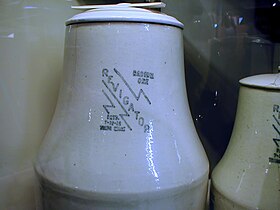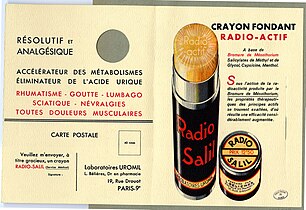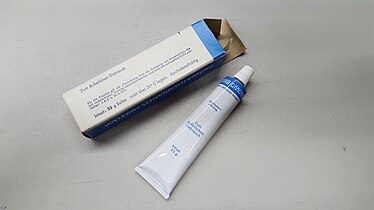Radium fad


The radium fad or radium craze of the early 20th century was an early form of radioactive quackery that resulted in widespread marketing of radium-infused products as being beneficial to health.[1] Many radium products contained no actual radium, in part because it was prohibitively expensive, which turned out to be a grace, as high levels of radium exposure can result in radiation-induced cancer.[2]
The fad began to fizzle out following the emergence of research that radium could be hazardous to health, and high-profile cases such as the Radium Girls and the death of Eben Byers, which proved this fact.[3][4]
In the United States, the 1938 Federal Food, Drug and Cosmetic Act outlawed deceptive packaging, further preventing companies being able to use radium as a marketing tool.[3]
Radium-infused products
[edit]Radium was added to, or used to market, a number of consumer goods. These included cosmetics, such as the brand Tho-Radia,[3] toothpaste, hair cream, and hemorrhoid cream.[4]
Radium was also used to market foods and drinks, although products such as Radium Brand Creamery Butter did not actually contain any radium.[4] Radithor, an "energy drink" of distilled water with traces of radium, was marketed as a panacea.[3] One of its most famous advocates, golfer Eben Byers, died in 1932 of radium poisoning through his consumption of the product.[3][4] A number of water sources (such as bottlers or artesian hot-spring spa hotels) rebranded themselves as "radium water" or radium springs to capitalize on the craze.[5]
Radium was also used to give products a glowing appearance, as in the case of watches painted with radium-containing paint.[3]
Radium was also used in some ceramics, including in the production of radium water crocks, whose purpose was to irradiate drinking water.[4]
Gallery
[edit]- Tho-Radia advertising poster
- Tho-radia products
- Radior cosmetics containing radium, 1918
- Tho-Radia face powder containing radium and thorium
- Revigorator, 1929, pottery crock lined with radioactive ore that emitted radon; drinking water in such a crock was considered curative.
- Crayon Fondant Radio-actif salve for muscular pain
- Radium Water Bath Department, top floor, Hotel Will Rogers, Claremore, Okla., U.S.A
- Weleda Uraninit-Salbe, radioactive salve for back pain containing radioactive uraninite ore containing radium, 1970s
See also
[edit]- Uranium glass
- Lead pipes
- Arsenic green (disambiguation)
- Asbestos
- Electrical quackery
- History of radiation protection
References
[edit]- ^ Suihkonen, Andrea (2021-04-16). "Atomic Panacea: The Radium Fad of the Early 20th Century". UWM Undergraduate Research Symposium.
- ^ ""Get Me A Radium Highball!": New York and the Radium Craze". New-York Historical Society (nyhistory.org). Retrieved 2024-01-21.
- ^ a b c d e f Prisco, Jacopo (2020-03-03). "When beauty products were radioactive". CNN. Retrieved 2024-01-21.
- ^ a b c d e Dotinga, Randy (2020-02-15). "The lethal legacy of early 20th-century radiation quackery". The Washington Post. Retrieved 2024-01-21.
- ^ "Before 'raw water,' radium water was the craze — and then people died". Chicago Tribune. 2018-03-03. Retrieved 2024-01-21.







